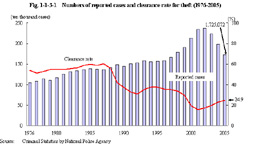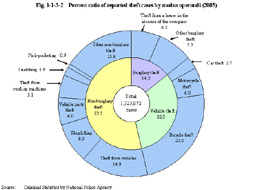| Previous Next Index Image Index Year Selection | |
|
|
Fig. 1-1-3-1 shows the numbers of reported cases and the clearance rate for theft over the last 30 years.
Fig. 1-1-3-1 Numbers of reported cases and clearance rate for theft (1976-2005) The number of reported cases for theft had been increasing and the clearance rate had been decreasing since 1995. However, brakes have been put on this tendency since 2003.The number of reported cases had increased significantly year by year from 1998, marking the worst record of 2,377,488 cases since the end of WW II in 2002. However, the number started to decrease after that, and in 2005 it decreased by 652,416 cases (27.4%) from 2002. The number of cleared cases was 429,038 cases (down by 18,912 cases (4.2%) from the previous year), and the number of persons cleared was 194,119 persons (down by 1,032 persons (0.5%) (id.)) in 2005. The clearance rate also recovered and rose by 9.2 points in 2005, compared to the year 2001, when the clearance rate was the lowest since the end of WW II. Fig. 1-1-3-2 shows the percent ratio of reported theft cases in 2005, by type of modus operandi. Fig. 1-1-3-2 Percent ratio of reported theft cases by modus operandi (2005) Explanation of termsPenal code offense Penal code offenses include (1) offenses prescribed by the Penal Code and (2) offenses that are prescribed by other acts but have common characteristics with those prescribed by the Penal Code. For instance, the Act on the Prevention and Punishment of Burglary, Robbery, Theft, etc. imposes a heavier punishment for theft that satisfies certain requirements as habitual recidivist theft, which shares characteristics with theft under the Penal Code and therefore is included in the category of penal code offense in the White Paper on Crime. For the precise scope of penal code offenses, see Notes. Special act offense Special act offenses refer to offenses other than penal code offenses, such as violations of the Road Traffic Act and violations of the Stimulants Control Act Non-traffic penal code offense Non-traffic penal code offenses refer to penal code offenses excluding negligence in the pursuit of social activities in traffic accidents. Negligence in the pursuit of social activities in traffic accidents A person who causes the death or injury of another through negligence in a traffic accident shall be charged for the offense of causing death or injury through negligence in the pursuit of social activities or gross negligence under Article 211 of the Penal Code. The offense in such case is referred to as negligence in the pursuit of social activities in traffic accidents. Since such offense is committed by negligence, and its influence on public security is different from that of homicide and theft, the White Paper on Crime deals with it separately from non-traffic penal code offenses in the category of penal code offenses for analysis, if necessary. Dangerous driving causing death or injury (Article 208-2 of the Penal Code), which was newly established upon the legal amendment in 2001, is included in non-traffic penal code offenses rather than negligence in the pursuits of social activities in traffic accidents. For the precise scope of negligence in the pursuit of social activities in traffic accidents, see Notes. Number of reported cases Number of cases that are reported to the police or other investigative authorities Crime rate Number of reported cases per 100,000 persons Number of cleared cases Number of cases that are cleared by the police or other investigative authorities, including cases disposed by police as minor offenses etc. in addition to those cases referred to public prosecutors Clearance rate Percentage of the number of cleared cases in the number of reported cases Number of persons cleared Number of offenders cleared by police or other investigative authorities |

